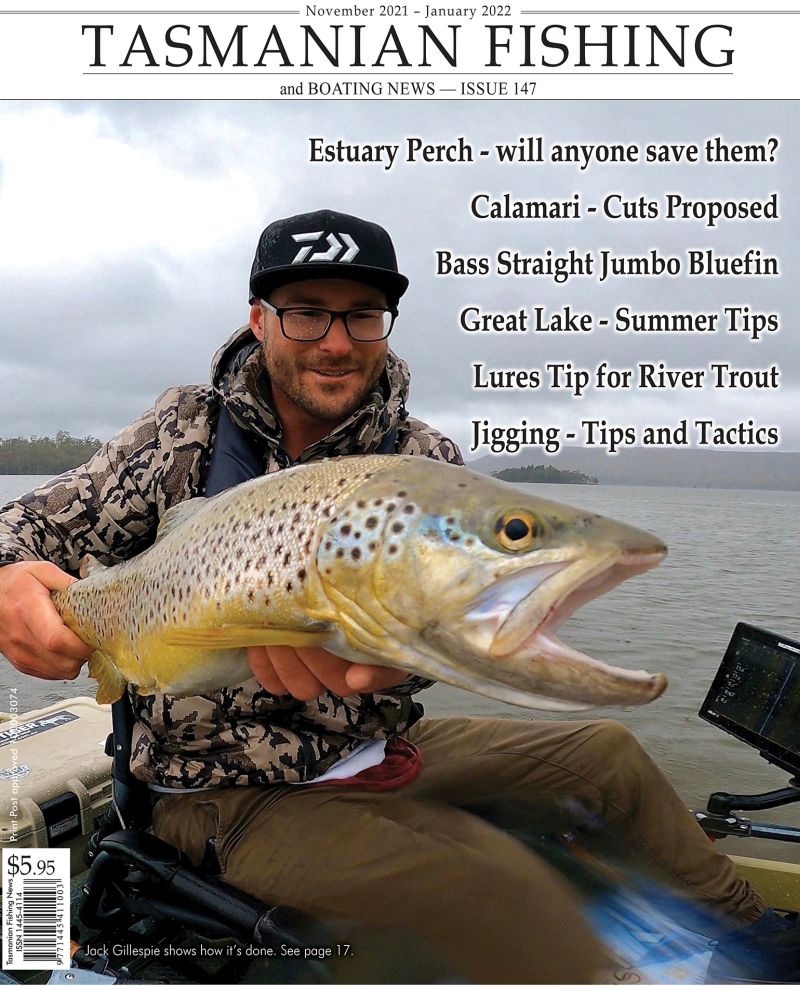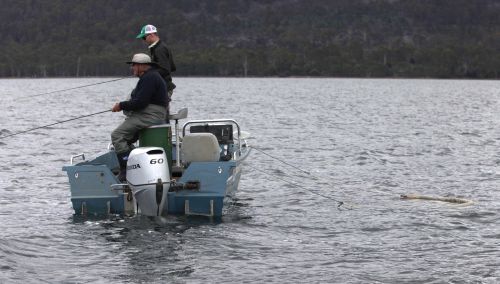So much water so close to home
by Greg French
One of the first assumptions anglers are inclined to make is that popular waters have been thrashed to death and that better fishing will be found if you are prepared to travel further afield. Be sure of this - popular waters are not popular without reason. They really do offer anglers (especially novices and intermediates) the best chance of catching fish.
A clear example is Little Pine Lagoon. This small shallow water is reserved solely for fly fishing and, square metre for square metre, kilometre of shore for kilometre of shore, it is far and away the most intensively fished lake in Tasmania. It yields some nine thousand brown trout annually at the rate of almost 1.5 fish per angler per day - statistics which few Tasmanian waters can match. It is fished because of the intensity and reliability of its two feature attractions - springtime tailers and (especially) summertime dun hatches. I admit that on a good dun day, when anglers are sprinkled over the surface like hundreds and thousands over fairy bread, the venue certainly looks over-fished but the reality is that on a day like this you will be hard pressed to find more productive fishing anywhere else in the highlands.
When you do decide to go to a big-name water the chances are you will try to find some solitude. It is hard to get enthusiastic about fishing the shore immediately in front of the main camping area, especially if it appears to have been exhausted by dozens of half-serious punters. Think about why the camping ground is sited where it is.
In Tasmania most formal grounds have evolved from informal sites, and these informal sites were traditionally used because they were both sheltered and adjacent to some of the best fishing shores. This cosy alliance comes about because in Tasmania the best trout habitat is often on the sheltered bank where, in the absence of erosive wave action, marshes have established and/or trout can be easily spotted. It is no coincidence that PumphouseBay at Arthurs Lake, Woodwards Bay carpark at Bronte Lagoon and Silver Plains at Lake Sorell (when the lake is healthy) are close to exceptional fishing.
Another thing about campsites and associated boat launching areas is that you stand a good chance of catching better than average trout which have been feeding regularly on discarded fish guts.
The truth is that the fishing in less popular waters is often inferior - witness the Western Lakes. The easy-access waters in the popular Nineteen Lagoons area and the Chudleigh Lake region are shallow and biologically productive. Not only do they hold exceptional fish but anglers can often see most of the lake bottom and so have a good chance of spotting the quarry. In contrast, the wilderness lakes west of the Great Pine Tier are mostly deep and overpopulated and consequently the trout are typically small and difficult to see. I continue to write enthusiastically about these remote waters but understand that it is the romance of the area, not the fishing per se, that makes the wilderness experience special.
Sometimes, too, you must dare to accept that a water is not actually fished as hard as it seems it should be. Although Hobart's population exceeds 200 000, surprisingly few people fish the estuary along which the city sprawls. This defies reason. From August to December, when the sea trout are following whitebait in from the ocean, the fishing in the Derwent estuary is superb! At this time of year I fish gravel shores illuminated by heavy industry and overlooked by high-density housing estates. Often I am alone, making short casts to 1-3 kg spears of silver, while the anglers residing in the houses 100 metres behind have opted to travel more than 150 km to the Central Plateau.
Another difficulty, especially for novices, is to get enthusiastic about fishing behind someone else. If your mate (or, worse still, a stranger!) is working up the bank immediately in front of you it is tempting to think that all the catchable fish will have been hooked or spooked. It is not necessarily so. While I prefer to fish virgin water, this is not always socially acceptable, appropriate or even possible - and I take heart in the knowledge that I have often found myself catching more fish than the person in front. Believe me, a confident angler can pull fish out of water metres behind another. You will be amazed at how many catchable trout less experienced, less confident anglers fail to see or (when blind casting) fail to lure out of their lies. Under most conditions, spooked trout quickly reoccupy disturbed water and are soon catchable once more. (When wading, trout often move into the silt plume directly behind you so that they can feast upon the beasties you have disturbed!)
If I have still failed to convince you of the merits of fishing popular waters, think about this: In Australia and New Zealand some of the very highest catch rates and biggest fish belong to waters with exceptional visitation. It is hard to beat the trouting available at Eucumbene, Monaro, the upper Murray, Rotorua or Taupo.
So why do any of us bother to fish obscure places? Perhaps the most compelling reasons are to broaden our experience and to find sanctuary, though the merits vary from district to district. If you just want to catch fish you really need to scour location literature to assess whether the extra effort is worthwhile. More often than not you will find that the very best sport is so close to home.



